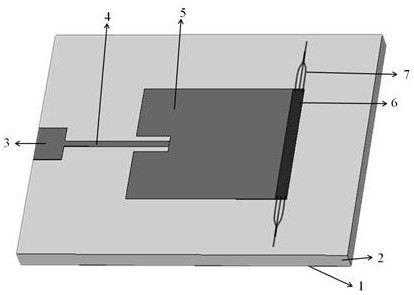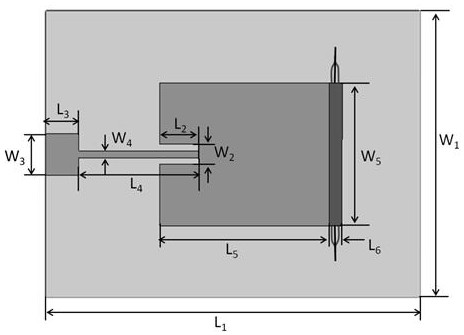Graphene-based optical carrier microwave antenna
An optical carrier microwave and graphene technology, which is applied to antennas, resonant antennas, antenna parts and other directions, can solve the problems of low optical signal conversion efficiency, high cost and complex structure of optical carrier microwave antennas, and achieves high speed and size. Small, simple hardware structure
- Summary
- Abstract
- Description
- Claims
- Application Information
AI Technical Summary
Problems solved by technology
Method used
Image
Examples
Embodiment 1
[0036] A graphene-based light-borne microwave antenna, the basic dimensions (unit: mm) are as follows:
[0037] That
[0038] Among them, the optical waveguide 7 has a height of 200nm and a width of 400nm. The material of the insulating dielectric substrate 2 of the microstrip patch antenna is FR-4 with a thickness of 1.5mm, wherein the relative dielectric constant is 4.3, and the loss tangent value is 0.025; the metal ground plate 1, the microstrip connecting line 3, and the impedance matching Both the transmission line 5 and the radiation patch 5 are made of copper; the feed structure of the microstrip line of the antenna adopts a side feed mode, and the input impedance is 50 ohms, which realizes impedance matching well.
[0039] see Figure 4, is the simulation result graph of the input reflection coefficient S11 under different graphene Fermi levels (corresponding to different optical signal intensities) of the present invention. The operating frequency of the graphen...
Embodiment 2-5
[0041] The basic dimensions (unit: mm) are as follows:
[0042] Example L 1* W 1
L 2* W 2
L 3* W 3
L 4* W 4
L 5* W 5
L 6* W 5
t h Example 2 31.2*28 2.5*1 2.5*1.9 9.5*0.5 14.2*11.8 05*11.8 0.018 0.06 Example 3 30.7*20 3.5*1 2.5*1.9 10*0.6 10*10 1*10 0.018 1 Example 4 27.7*22 3.5*2 2.8*2.9 9*0.65 14*18 1.5*18 0.035 1.5 Example 5 26.5*22 3.2*1.4 3.5*3.5 8.5*0.48 15.6*13.8 1.2*13.8 0.026 2
[0043] Example The size range of optical waveguide is (100~400)×(400~2000) Example 2 400×2000 Example 3 100×400 Example 4 280×1000 Example 5 300×1600
[0044] The unit of size is nm. The operating frequency of the graphene optical microwave antenna in this implementation is 3.5-6 GHz.
[0045] Wherein, the metal ground plate 1 and the metal structure layer (microstrip connection line 3, impedance matching transmission line 4 and radiation ...
PUM
| Property | Measurement | Unit |
|---|---|---|
| Thickness | aaaaa | aaaaa |
Abstract
Description
Claims
Application Information
 Login to View More
Login to View More - R&D
- Intellectual Property
- Life Sciences
- Materials
- Tech Scout
- Unparalleled Data Quality
- Higher Quality Content
- 60% Fewer Hallucinations
Browse by: Latest US Patents, China's latest patents, Technical Efficacy Thesaurus, Application Domain, Technology Topic, Popular Technical Reports.
© 2025 PatSnap. All rights reserved.Legal|Privacy policy|Modern Slavery Act Transparency Statement|Sitemap|About US| Contact US: help@patsnap.com



